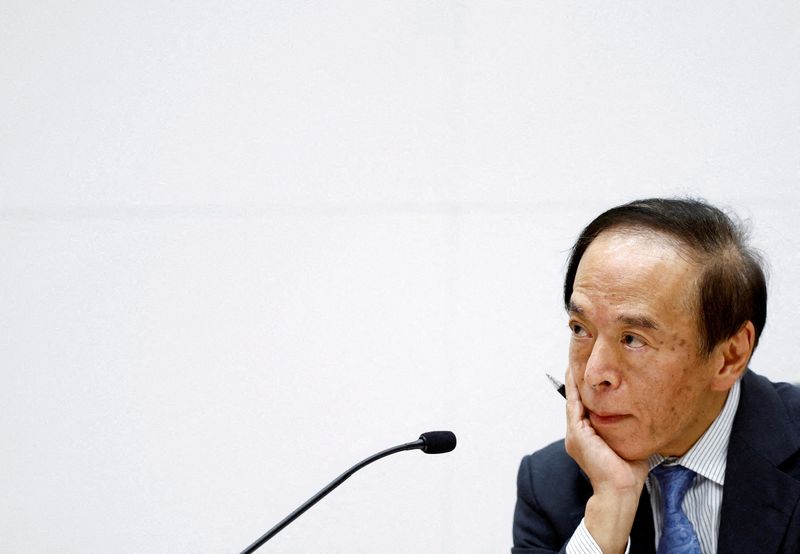By Leika Kihara
JACKSON HOLE, Wyoming (Reuters) - For academics and policymakers gathered at the U.S. Federal Reserve's annual Jackson Hole economic conference to debate how central banks can affect market perceptions on the course of monetary policy, the Bank of Japan might appear to have gotten it right in July when it raised rates for a second time.
In March the BOJ managed at last to end eight years of negative interest rates. The next month it began dropping hints it would kick off steady interest rate hikes if inflation remained on track to meet its forecasts.
The message went ignored by markets, until last month. That's when the BOJ backed hawkish signaling with action: It lifted short-term rates to 0.25% from 0-0.1% in a surprise move that triggered a global unwinding of carry trades that for the better part of a decade had been funded with ultra-cheap Japanese yen.
The subsequent market rout forced the BOJ to backtrack and offer reassurance it won't hike again until markets stabilise. And yet, it showed how central bank communication has maximum impact when words are matched with action.
The BOJ's experience dovetails with findings in a new research presented at this year's Jackson Hole conference, where global central bank policymakers discussed ways to enhance their communication with markets.
The paper - "Changing Perceptions and Post-Pandemic Monetary Policy" - showed how it took substantial rate hikes by the Fed for the public and markets to fully grasp how committed policymakers were to ensuring inflation returned to the U.S. central bank's 2% target.
"Policy rate actions contribute to, and may even be necessary for, the effectiveness of communication, particularly when uncertainty about the monetary policy framework is high," the authors wrote. "As our evidence shows, a timely policy rate response to inflation matters not only for influencing immediate financial conditions, but also for signaling that policy makers are serious about responding to future inflation news."
To be sure, the highest Japan's inflation rose was to 4.2% in January 2023, well below the 7.1% peak U.S. rate that pushed the Fed into rate-hike overdrive in June 2022. Japanese inflation in July was 2.7% and has held above the BOJ's 2% target for more than two years, with broadening wage hikes starting to push up services prices.
In current projections made in July, the BOJ expects core consumer inflation to stay around its target through the year ending in March 2027. It has also warned that yen depreciation could fan inflationary risks that warrant steady rate hikes.
"We're expecting that as inflation expectations remain stable at their new level close to 2%, the BOJ will start normalising policy rates," IMF chief economist Pierre-Olivier Gourinchas told Reuters on Friday.
"Certainly in our assessment, there is scope for further normalisation of monetary policy going forward, and policy rates to increase gradually for some time," he said.
CLEARER GUIDANCE NEEDED
The BOJ has said it was clear on what would trigger rate hikes and that its policy decisions were more data-driven.
But the fact it took an actual rate hike to get its hawkish message across highlights the communication challenge facing BOJ officials, including Governor Kazuo Ueda.
The key complaint among analysts was that despite stressing it would be "data-dependent" in deciding when to raise rates, the BOJ pulled the trigger before there were clearer signs that consumption would emerge from the doldrums.
That led them to believe the BOJ's July hike was driven by a desire to support a nose-diving yen rather than by strong economic data.
"The fundamental problem with the BOJ's communication is that it needed to offer hawkish guidance to stem yen falls, even though many measurements of the economy were weak," said Shigeto Nagai, head of Japan economics at Oxford Economics.
In an about-face from the hawkish July communication, BOJ Deputy Governor Shinichi Uchida reassured jittery markets this month that it won't hike rates while markets remained unstable.
With a measure of calm now restored, though, Ueda returned again to hawkish jawboning, telling parliament on Friday the BOJ will keep hiking rates to levels seen as neutral - neither stimulating nor restricting the economy.
To avoid confusing markets, the BOJ needs a medium-term framework with clearer guidance on its long-term rate hike path, some analysts say.
While the BOJ issues quarterly long-term growth and inflation forecasts, it does not have a Fed-style dot plot of policymaker rate projections nor an estimate of the neutral rate.
Ueda said on Friday there was not enough data to come up with a credible estimate on Japan's neutral rate, though he added the BOJ would keep trying.

"The primary task for the BOJ is to pull the market's focus away from the next meeting or the next hike, and guide it more toward where rates will go over the medium term," said Jeffrey Young, chief executive officer of U.S. research firm DeepMacro.
"That's something that we don't really have a lot of guidance on."